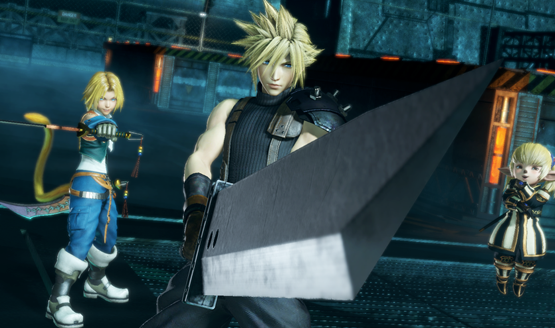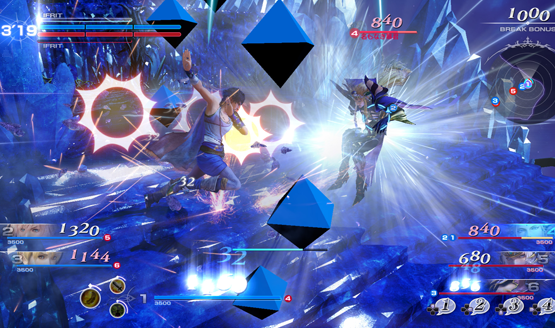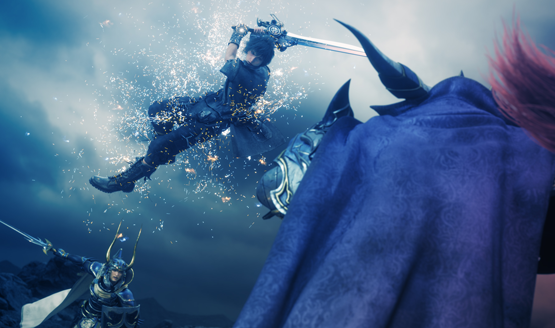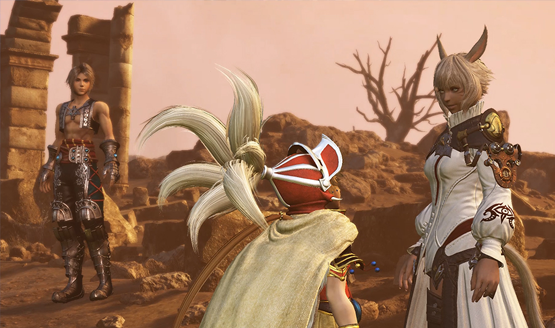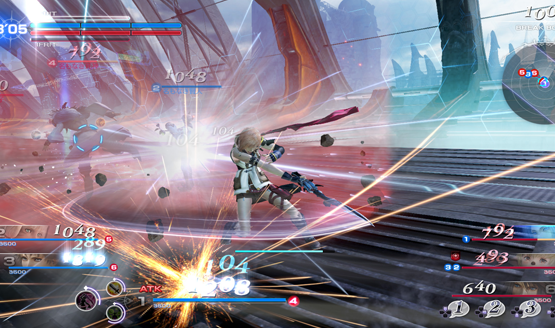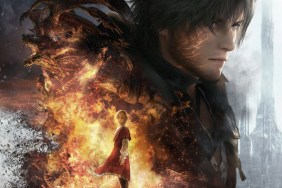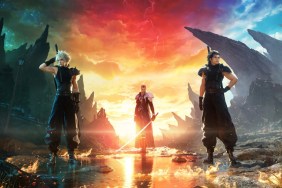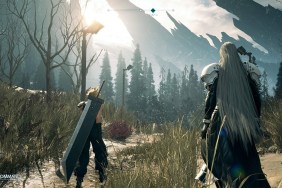It seems like just about every gamer has a Final Fantasy story. They’ve got their first Final Fantasy, their favorite Final Fantasy characters, and their own opinion about which Final Fantasy is best. It only makes sense to have the heroes and villains from 30 years of the series clash with one another in the biggest Final Fantasy crossover since Kingdom Hearts. Dissidia Final Fantasy NT is the follow up to 2008’s Dissidia Final Fantasy and 2011’s Dissidia 012 Final Fantasy, both released on the PlayStation Portable. Despite being a mashup of characters from an iconic RPG series, Dissidia is actually a fighting game at its heart, though many of the RPG roots can be seen.
The Final Fantasy heart is worn on Dissidia’s sleeve. It doesn’t shy away from being a fan’s dream of all the “what if” scenarios and fan fiction between the main heroes and villains of the series. Would Squall or Cloud emerge victorious from a duel? Is Sephiroth or Kefka the stronger villain? Can Tidus finally lay a beat-down on his abusive father, Jecht? Every main numbered game in the series gets representation, along with Tactics and Type-0, for a total of 28 characters. That’s a lot of possible combinations of three character team-ups facing off against each other. The current roster consists of every main hero and villain in the series (for the most part). DLC will bring six additional unannounced side characters from across various games.
At a glance, one might think that Dissidia is a hack-and-slash brawler, but there’s a lot of nuance, strategy, and skill that go into its deep fighting systems. Entering the fight thinking you can button mash your way to victory is a good way to ensure a quick loss. Team composition, character selection, knowing the characters’ movesets, and knowing how the tactical aspects of the game work are all key to victory. To this end, there are some places where the game stumbles, and some other places where incompetent teammates can ruin your day, but when the pieces fall into place, it’s a brilliantly tactical and addicting fighter that I just can’t stop playing.
There are two main types of attacks that players will use. The idea is to target players using bravery attacks to decrease their lethality, and build up your own to unleash devastating HP attacks that eliminate players. Bravery attacks will lower the opponent’s bravery score and increase your own, but they can’t be used to eliminate players and have no effect on their health pool. HP attacks will do damage equivalent to the bravery score. EX skills and summons round out the move set with unique abilities that offer a variety of buffs and debuffs. It’s a fairly complex system that requires thinking tactically. Do I unleash my HP attack now, or continue to attempt to build up my bravery? Do I target the enemy with high bravery and risk getting hit with an HP attack, or pursue the opponents that have yet to build up their numbers? On top of all that, you have to consider each player’s real-time targeting, character class, and a number of other small factors that can make or break a match.
Makeup of a Good Team
The importance of team composition is so high that I wish matchmaking worked differently. Currently, I select a character and it matches me with two other players and pits us against a team of three other matched-up players on the opposing side. Sometimes the compositions I get matched with are terrible, going against what even the game itself suggests in its tutorials. Three vanguard class characters should not be made to face off against multiple marksmen, yet I’ve seen it happen more than once. Either the matchmaking system should prioritize team composition (ie. matching players that select different classes of characters), or character selection ought to occur after players are matched together.
Three versus three online matches make up the brunt of the gameplay. It was shocking how many people I matched up with that simply didn’t know how to play. I had one match where a teammate was building up their own bravery to one-hit-kill numbers, but would never unleash the devastating HP attacks that would have actually dealt damage. In others, players clearly didn’t know how to use the character or class that they were playing, or tried to go lone wolf when team play is so necessary. The nature of online team-based gameplay dictates that you’ll end up with some bad teammates, but Dissidia could do more to mitigate the issues.
HP and bravery attacks are each limited to one button (square for HP and circle for bravery), but positioning and other factors will unleash a variety of moves. Squall, for example, has seven different bravery attacks that are based upon whether he is airborne or on the ground, and what direction the analog stick is being pushed when circle is pressed. Knowing the ins-and-outs of these moves is akin to knowing combos in a traditional fighting game. You might be able to get by mashing circle and seeing what happens, but knowing and planning attacks is going to be far more valuable to your team. Dissidia never details these moves in any way, leaving players to figure them out for themselves–hopefully offline.
Due to the complex and frenetic tactical nature of the gameplay, I had to make my way through the tutorials twice (along with a number of trial and error matches) before I started to really understand the nuances that would lead to victory, but there was still a lot I was missing out on. Dissidia Final Fantasy NT lacks any kind of individual character tutorials, or even in-game move lists. Every character class is unique, and every character plays very differently. Having to find a character guide online just to work out what a character’s unique EX skill does is a failure on the game’s part to give players all of the tools they need to perform their best.
Nowhere in-game does it tell me that Cloud’s unique EX skill shortens the charge times for his attacks, or that Ace’s is about drawing different cards for a variety of skills. How am I supposed to know that Cloud can perform a ranged bravery attack by being on the ground, pulling backwards on the analog stick, and tapping circle? In a game that could desperately use detailed interactive character tutorials to allow players to understand their individual nuances, it doesn’t even have a basic move list for each avatar.
A failure to understand how to play might be fine for a one-on-one fighting game–and moving out of the lower ranks should hypothetically ensure better matchmaking–but a team-based online game has a responsibility to equip players as best as possible before they impact other people’s experience. Maybe require a certain character level before being allowed to take that character into online play, or mandatory tutorials before being allowed to matchmake. At the very least, Dissidia needs to offer detailed character move lists in game, if not full blown character tutorials that walk players through the wealth of abilities that they are capable of. Being thrown into the deep end isn’t only damaging for the player, but for their teammates as well.
When you have players who know what they are doing, though, Dissidia Final Fantasy NT is a blast. Once everything clicked for me, I was happy to jump in with some of my favorite characters and repeatedly hit the continue button battle after battle. Matches are relatively short, often coming in at under three minutes. Quick, bite-sized gameplay is perfect for this type of game, and ensures I can get in a few matches, even if I only have a short time to play. If I had a better understanding of each character, I might be willing to experiment with more than the three or four default characters I come back to match after match.
Telling a Fantasy Story
Dissidia’s story is fun simply because of the interaction between various Final Fantasy characters. Seeing typically jovial heroes trying to cheer up the stoic loners is entertaining, and Vaan and Onion Knight fighting for the affections of Y’shtola is hilarious, especially as Y’shtola laughs knowingly at their pathetic attempts. Most of the scenes are strictly about the dialogue. Warrior of Light, Final Fantasy’s first and most altruistic hero, teaches some valuable lessons to Noctis, Final Fantasy’s newest hero. Lightning and Squall are stoic together. Cloud and Bartz face off against Exdeath and Sephiroth. The pairings are well thought out, both on the hero and villain side, to shine a new spotlight on each character and put them in unusual interactions. The voice acting is particularly well done all around, and the actors help to sell every scene that they are part of.
Unlocking the story cinematics and battles is done through completion of online matches and ranking up player level, which grants Memoria. Players can then use Memoria to open nodes on the story map to progress to the next scene. You can also rank up and earn Memoria through offline play and Gauntlet matches, but it was an interesting choice to tie Dissidia’s story into the general gameplay instead of making it a separate part of the game. Imagine if a game like Overwatch took the online character shorts and comics and made them unlockable in game by playing online matches and leveling up. It makes it feel like there is a certain value to my progress through the campaign–like I earned the right to view the next scene or take part in the next battle. Everything feels tied together in a complete package rather than pieces of something bigger. Of course, some who are interested only in the story may object, but Memoria can be earned entirely offline without ever touching the online play.
Rearranging Three Decades of Songs
Perhaps one of the most iconic parts of three decades of Final Fantasy, the music in Dissidia doesn’t disappoint. Featuring classic versions and wholly new arrangements of various songs from across the series, the battles and menus are filled with a soundtrack that immediately has me looking for a purchase button. Dissidia’s director allowed–or rather, required–that the game’s composer make radical rearrangements to classic Final Fantasy tracks, so even longtime fans are treated to a bold new take on the familiar. Some tracks do need to be unlocked using gil earned after matches, or randomly acquired through “treasures,” which are Dissidia’s loot boxes. Don’t worry, there aren’t any microtransactions. Treasures can only be earned on player level-ups, and everything can be unlocked directly using gil so randomness won’t keep you from getting that Sephiroth costume you really want.
With that, the unlocks and customizations are quite fun, and offer a unique flavor to each match, even if you have multiple of the same characters fighting. Players can equip each and every character with a variety of strictly cosmetic costumes and weapons. It keeps everyone on an even footing in the online space, but gives a fun goal to chase after. You can even create custom battle music playlists so that the music is curated just for you. Additional characters and cosmetics could certainly keep the game supported long term, so hopefully Team Ninja and Square Enix decide to do more beyond the six additional characters that should be arriving later this year.
An online game wouldn’t be complete without matchmaking wait times and connection issues, and the launch week of Dissidia has suffered from a bit of both. Though I have never been fully booted from a match, some battles encounter periodic connection-based freezes that can really impact that rapid tactical nature of the game. Fortunately, most games are fine, but the 10% of games that suffer from stuttering really leave a bad taste. These matches often end quickly, and then it’s back to matchmaking, which can sometimes take four or five minutes. Time limits on matches are set at three minutes, so sometimes I was spending more time matching with other players than I was actually playing the game. It can vary wildly, often depending on what time of day I was playing.
It might seem like I maintain a high criticism of Dissidia, but I actually love everything about it. My criticisms stem from the game missing some important elements that could elevate the player experience. The deep fighting system is consistently interesting, and I found myself learning from my mistakes. Watch my flanks and minimap. Don’t engage one-on-one far from my team. Try to flank opponents that are attacking my teammates. Don’t hold HP attacks for high-risk big plays. Dodging and blocking are just as important as keeping opponents on the sharp end of my blade. Every win and loss allowed me to get better, even if I had to look outside the game to understand how to play each character.
Without the inclusion of basic in-game move lists or character tutorials, Dissidia Final Fantasy NT presents players with a pretty steep barrier to entry and learning curve. It does itself a disservice by not providing the tools necessary for players to get the most out of the experience. As a huge Final Fantasy fan, I was determined to learn the ins-and-outs of Dissidia’s complex systems. Once I crested that peak, I was addicted. “Just one more match” has never become more a part of my gaming vocabularly than during the last week while pitting Bartz against Kuja or teaming Cloud of Darkness with Y’shtola. Dissidia is Final Fantasy through and through, from epic battles to incredible music to deep and obscure mechanics that most players won’t fully understand until they are hours into the game.
Dissidia Final Fantasy NT review code provided by publisher. Version 1.01 reviewed on Standard PS4. For more information on scoring, please read our Review Policy.
-
Deep and tactical frenetic team-based gameplay
-
Mashup of nostalgia for every Final Fantasy fan
-
Amazing rearranged soundtrack
-
Bite-sized gameplay for quick matches
-
No in-game character tutorials or move lists
-
Getting paired with teammates who don't know how to play
